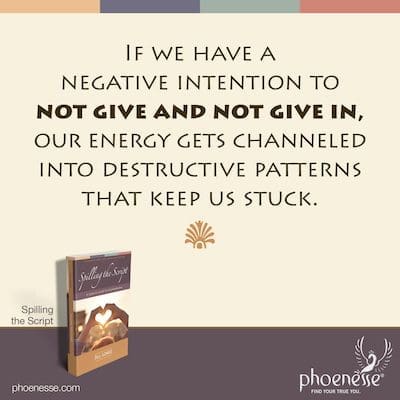
The idea that we are made in the image of God expresses the reality that like God, we have free will to create. As creators, we can use our intentionality to mold our life forces however we want. But if we have a negative intention to not give and not give in, our energy—which could have been used for creative purposes—gets channeled into destructive patterns that keep us stuck in what the Guide calls vicious circles.
All of our distortions and blindnesses create vicious circles. One primary vicious circle lives in everyone, hidden (see below). There are also many other individual vicious circles. They begin in childhood, where all images are formed. In order to dissolve them, we need to uncover the entire vicious circle. We start by finding an off-ramp, or a way out.
An example of a vicious circle might be: I want love, I don’t get it 100% perfectly due to the other’s imperfections, I cover up feeling hurt, I judge, I reject, I am lonely and isolated, I want love, repeat. Underneath this is perhaps the belief, “I’m not enough and I’ll never be enough.”
It may seem that the only options are to go into judgment—which supports the pride of feeling better than—or feel the pain of the rejected inner child—and die to the pain of this illusion. So we keep judging the other—to avoid feeling affected—or possibly collapse into worthlessness and judge the self.
What the undistorted Lower Self energy is really wanting to say is, “I have a need!” Instead the Lower Self says, “I will use the demand that you show up the way I want to justify staying in separation.” Its intention is to not take self-responsibility. We need to heal this wound to see the divine longing that is behind this negativity.
There is a basic misconception here that it is not OK to have needs. Staying in deprivation creates acute pain, confirming the belief that “I can’t have it.” Such misconceptions are used by the Lower Self to justify its demands.
Learn more in Gems, Chapter 13: Landing our Desires by Letting Go of our Demands.
Based on early childhood experiences, the energy has gotten attached to a push-pull dynamic that can never be satisfied: “I reject what I want—love—because it hurts the way I get it.” We either make the other wrong, or we are wrong. Pride says, “I need to make the other wrong.”
Fear says, “I’m afraid they will hurt me.” Self-will says, “I choose to stay isolated to protect my vulnerability.” Note that statements coming from the mask, such as, “It’s not safe to be in relationship,” are an effect, not a cause, and are not at the level of negative intention.
If we cannot find a way out, it is because of our own choice—our negative intention—to stay stuck. It is both a defense and a way to punish others: “I don’t like it so I want to punish you.” It is a way of not giving anything and demanding everything. Our withholding of love, even if it is due to fear, is as hurtful as active cruelty.
In emotional maturity, we would be able to give and receive love, even if not perfectly, and get our needs met. Instead, negative creations are now being perpetuated in which there is a demand for 100% perfect love, which does not exist on the earth plane.

If we have a problem that we can’t seem to solve, there is likely a negative intention that is still hidden. Negative intention in one area seeps across many areas. But we will not find a way out if we play a game of helplessness, dependency and victimization. Self-responsibility is the way to find new solutions.
To heal negative intention, we need to give. Off-ramps for this example include: recognizing the anger of an emotional reaction; feeling the feelings under the anger; speaking one’s truth about feeling hurt; being curious about the other; having compassion for the other; accepting that others aren’t perfect.
People in addiction recovery programs are often encouraged to “get outside themselves,” which means to find a way to give of themselves. For some, this means working with others, for others it means making the coffee. The important thing is to give from the center of ourselves.
This breaks a person out of their inward facing orientation. By re-orienting ourselves to giving, doors also open for receiving—because giving and receiving are one. This lets in the possibility to receive the respect, affection, appreciation—in short, love—the soul longs for.
Learn more in Living Light, Chapter 19: THE THREE STAGES OF DEVELOPMENT | The Movement Toward Giving, and in Bones, Chapter 17: Overcoming our Negative Intention by Identifying with our Spiritual Self.
We work with our withholding by going into the resistance that is held in the body and in the breath. We will first expose the anger that was a protective device saying, “No, this is not what I want!” Under that will be the pain of not receiving perfect love. We must use self-responsibility to ferret out our intention: “What makes me say No?”
We need to re-educate the inner child to realize that, as in the example given, he or she is enough and there is nothing wrong with having a need. Then we can use visualization to plant the seed of truth that fulfillment of our longing is possible. And finally, we accept the reality that sometimes the other is going to be able to love us, and sometimes they’re not.
| Immature Attempt to Get Love | Mature Way to Get Love | |
| Person demands love. • Unwilling to give it. | Person wants love and is willing to give it. | |
| Uses a Forcing Current. • Overt and covert control. | No fixed ideas about how it should look. | |
| Other cannot give love due to Forcing Current and their own issues. | Flexible | |
| Person feels slighted. | Disappointments don’t kill you. | |
| Hostility and aggression are hidden behind withdrawal, attack or submission. | No hidden hostility. | |
| Other perceives hostility and reacts. | No resentments. | |
| Bleakness | Other feels openness and spontaneous flow. | |
| Escape to fantasy and imagined situation of getting approval, love. | Get love and give love. | |
| Want instant gratification. | ||
| Dramatize, build cases against the other, seek sympathy. | ||
| Feel disappointment. | ||
| Demand love. | ||
The key to life is to find and align with God’s will. To do that, we must find our own will—our own positive intention. And that takes commitment. Anything less than 100% commitment will not give us the results we want. Half-measures avail us nothing.
We need a holistic approach, combining our thinking abilities, our intuition and meditation. It won’t work to just do the right thing if our motivation is wrong. We will end up still feeling like we’re a persecuted victim in a haphazard world.
If, after much work, a vicious circle will still not dissolve, the solution may be found in looking at opposites. For example, if we struggle with a great amount of fear, it may be good to look at how we actually desire to make others afraid of us.
Learn more in After the Ego, Chapter 8: Commitment: Cause and Effect.
The Primary Vicious Circle
1. Have inferiority feelings due to artificially high standards.
2. Demand to be loved/admired. “I have failed. I am inferior. If I could receive great love/respect/admiration, it will prove I am not worthless.”
3. Duality: Perfect love exists; if I didn’t get it, my parents were wrong.
4. Craving for love becomes immature: Child wants love from everyone, but has no intention of loving.
5. Feeling of rejection causes hatred, resentment, hostility and aggression toward the ones the child love most.
6. This conflict in the psyche causes shame.
7. Shame is pushed into the unconscious.
8. Hate for parents creates guilt, which becomes the source of conflict for the adult.
9. Guilt creates desire to be punished.
10. Unconscious fear of punishment arises.
11. This shortcuts feelings of happiness, joy and pleasure. You feel undeserving.
12. Child fears that if these good things happen, the punishment will be greater.
13. Child unconsciously avoids happiness by creating situations and patterns that destroy everything most dearly wished for.
14. Duality: Yearn for happiness; fear happiness.
15. The stronger one desires happiness, the guiltier one feels.
16. Images are gathered which fortify this vicious circle.
17. Fear of punishment from others is great. Unconsciously decide to punish self to avoid humiliation, helplessness, degradation.
18. Self-punishments include physical disease, mishaps, difficulties, failures and conflicts, depending on images.
Split: Desire not to be punished; bargain to be best at everything to atone for past hate.
Truth: No one needs to be punished. We are lovable as we are.
Return to Spilling the Script Contents



